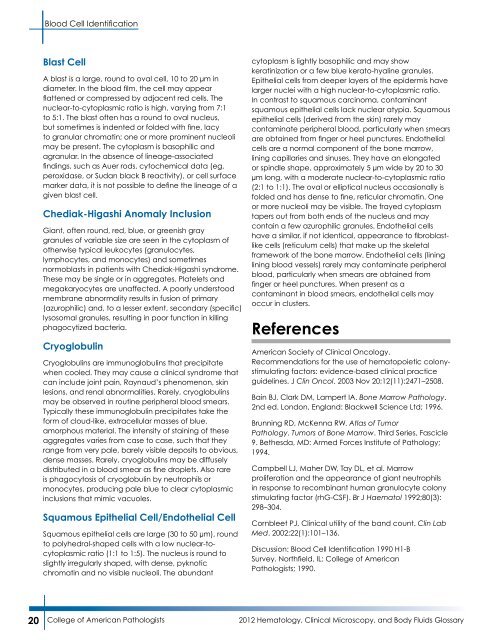Hematology and Clinical Microscopy Glossary - College of American ...
Hematology and Clinical Microscopy Glossary - College of American ...
Hematology and Clinical Microscopy Glossary - College of American ...
You also want an ePaper? Increase the reach of your titles
YUMPU automatically turns print PDFs into web optimized ePapers that Google loves.
20<br />
Blood Cell Identification<br />
Blast Cell<br />
A blast is a large, round to oval cell, 10 to 20 μm in<br />
diameter. In the blood film, the cell may appear<br />
flattened or compressed by adjacent red cells. The<br />
nuclear-to-cytoplasmic ratio is high, varying from 7:1<br />
to 5:1. The blast <strong>of</strong>ten has a round to oval nucleus,<br />
but sometimes is indented or folded with fine, lacy<br />
to granular chromatin; one or more prominent nucleoli<br />
may be present. The cytoplasm is basophilic <strong>and</strong><br />
agranular. In the absence <strong>of</strong> lineage-associated<br />
findings, such as Auer rods, cytochemical data (eg,<br />
peroxidase, or Sudan black B reactivity), or cell surface<br />
marker data, it is not possible to define the lineage <strong>of</strong> a<br />
given blast cell.<br />
Chediak-Higashi Anomaly Inclusion<br />
Giant, <strong>of</strong>ten round, red, blue, or greenish gray<br />
granules <strong>of</strong> variable size are seen in the cytoplasm <strong>of</strong><br />
otherwise typical leukocytes (granulocytes,<br />
lymphocytes, <strong>and</strong> monocytes) <strong>and</strong> sometimes<br />
normoblasts in patients with Chediak-Higashi syndrome.<br />
These may be single or in aggregates. Platelets <strong>and</strong><br />
megakaryocytes are unaffected. A poorly understood<br />
membrane abnormality results in fusion <strong>of</strong> primary<br />
(azurophilic) <strong>and</strong>, to a lesser extent, secondary (specific)<br />
lysosomal granules, resulting in poor function in killing<br />
phagocytized bacteria.<br />
Cryoglobulin<br />
Cryoglobulins are immunoglobulins that precipitate<br />
when cooled. They may cause a clinical syndrome that<br />
can include joint pain, Raynaud’s phenomenon, skin<br />
lesions, <strong>and</strong> renal abnormalities. Rarely, cryoglobulins<br />
may be observed in routine peripheral blood smears.<br />
Typically these immunoglobulin precipitates take the<br />
form <strong>of</strong> cloud-like, extracellular masses <strong>of</strong> blue,<br />
amorphous material. The intensity <strong>of</strong> staining <strong>of</strong> these<br />
aggregates varies from case to case, such that they<br />
range from very pale, barely visible deposits to obvious,<br />
dense masses. Rarely, cryoglobulins may be diffusely<br />
distributed in a blood smear as fine droplets. Also rare<br />
is phagocytosis <strong>of</strong> cryoglobulin by neutrophils or<br />
monocytes, producing pale blue to clear cytoplasmic<br />
inclusions that mimic vacuoles.<br />
Squamous Epithelial Cell/Endothelial Cell<br />
Squamous epithelial cells are large (30 to 50 μm), round<br />
to polyhedral-shaped cells with a low nuclear-to-<br />
cytoplasmic ratio (1:1 to 1:5). The nucleus is round to<br />
slightly irregularly shaped, with dense, pyknotic<br />
chromatin <strong>and</strong> no visible nucleoli. The abundant<br />
cytoplasm is lightly basophilic <strong>and</strong> may show<br />
keratinization or a few blue kerato-hyaline granules.<br />
Epithelial cells from deeper layers <strong>of</strong> the epidermis have<br />
larger nuclei with a high nuclear-to-cytoplasmic ratio.<br />
In contrast to squamous carcinoma, contaminant<br />
squamous epithelial cells lack nuclear atypia. Squamous<br />
epithelial cells (derived from the skin) rarely may<br />
contaminate peripheral blood, particularly when smears<br />
are obtained from finger or heel punctures. Endothelial<br />
cells are a normal component <strong>of</strong> the bone marrow,<br />
lining capillaries <strong>and</strong> sinuses. They have an elongated<br />
or spindle shape, approximately 5 μm wide by 20 to 30<br />
μm long, with a moderate nuclear-to-cytoplasmic ratio<br />
(2:1 to 1:1). The oval or elliptical nucleus occasionally is<br />
folded <strong>and</strong> has dense to fine, reticular chromatin. One<br />
or more nucleoli may be visible. The frayed cytoplasm<br />
tapers out from both ends <strong>of</strong> the nucleus <strong>and</strong> may<br />
contain a few azurophilic granules. Endothelial cells<br />
have a similar, if not identical, appearance to fibroblastlike<br />
cells (reticulum cells) that make up the skeletal<br />
framework <strong>of</strong> the bone marrow. Endothelial cells (lining<br />
lining blood vessels) rarely may contaminate peripheral<br />
blood, particularly when smears are obtained from<br />
finger or heel punctures. When present as a<br />
contaminant in blood smears, endothelial cells may<br />
occur in clusters.<br />
References<br />
<strong>American</strong> Society <strong>of</strong> <strong>Clinical</strong> Oncology.<br />
Recommendations for the use <strong>of</strong> hematopoietic colonystimulating<br />
factors: evidence-based clinical practice<br />
guidelines. J Clin Oncol. 2003 Nov 20;12(11):2471–2508.<br />
Bain BJ, Clark DM, Lampert IA. Bone Marrow Pathology.<br />
2nd ed. London, Engl<strong>and</strong>: Blackwell Science Ltd; 1996.<br />
Brunning RD, McKenna RW. Atlas <strong>of</strong> Tumor<br />
Pathology. Tumors <strong>of</strong> Bone Marrow. Third Series, Fascicle<br />
9. Bethesda, MD: Armed Forces Institute <strong>of</strong> Pathology;<br />
1994.<br />
Campbell LJ, Maher DW, Tay DL, et al. Marrow<br />
proliferation <strong>and</strong> the appearance <strong>of</strong> giant neutrophils<br />
in response to recombinant human granulocyte colony<br />
stimulating factor (rhG-CSF). Br J Haematol 1992;80(3):<br />
298–304.<br />
Cornbleet PJ, <strong>Clinical</strong> utility <strong>of</strong> the b<strong>and</strong> count. Clin Lab<br />
Med. 2002;22(1):101–136.<br />
Discussion: Blood Cell Identification 1990 H1-B<br />
Survey. Northfield, IL: <strong>College</strong> <strong>of</strong> <strong>American</strong><br />
Pathologists; 1990.<br />
<strong>College</strong> <strong>of</strong> <strong>American</strong> Pathologists 2012 <strong>Hematology</strong>, <strong>Clinical</strong> <strong>Microscopy</strong>, <strong>and</strong> Body Fluids <strong>Glossary</strong>
















